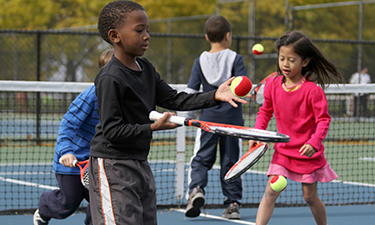 Traditional youth sports have been declining in popularity for a number of years, chased away by an overemphasis on winning, an overreliance on travel teams, injuries, burnout and the increase in popularity among nontraditional sports and activities.
Traditional youth sports have been declining in popularity for a number of years, chased away by an overemphasis on winning, an overreliance on travel teams, injuries, burnout and the increase in popularity among nontraditional sports and activities.
One sport, however, has defied that trend: tennis. Buoyed by the USTA’s youth tennis initiatives, tennis is growing — and thriving. A 2012 study by the Taylor Research Group found that tennis participation in the U.S. was at its highest levels in three years and that the biggest increase, at 13 percent, was among kids ages 6 to 11.
A big reason for that growth is the development of the game at park and recreation departments. Tennis grows strongest at its grass roots, at public parks and through the afterschool programs, clinics and camps that draw kids in and keep them on the court — and in the game — for life.
Best of all, it’s never been easier to start a youth tennis program, or to grow an existing program. The USTA now offers an array of tools to take your tennis program to the next level.
“[USTA’s marketing materials and tools] brought people to the parks who did not know about the parks or tennis programs,” says Cindy Harkins, park supervisor for Seminole County Leisure Services in Florida. “It was great exposure. It also provided an opportunity to show tennis as fun, easy to learn and a great activity the whole family can play together. [Through the first three quarters of 2013], our overall tennis programs and revenue increased by 10 percent compared to all of 2012.”
To better accommodate and accelerate the growth of tennis sized right for age and ability, the USTA has invested in constructing and refurbishing courts, building new 36- and 60-foot courts and painting blended lines on the traditional 78-foot courts. In March, the 10,000th court for kids 10 and under was completed, marking a milestone event in a three-year-long program that has seen nearly 10 youth courts constructed every day.
To further that growth, the USTA has committed to install at least 5,000 new kid-sized courts; train at least 15,000 new youth coaches, trainers and volunteers; and engage at least 300,000 kids in afterschool and summer programs over the next three years (2014–16).
“10 and Under Tennis has increased our programming and the number of new people coming to our facility,” says Mike Woody, executive director of the Midland Community Tennis Center in Michigan. “That has meant more money, better business and more kids playing tennis. I would recommend it to anyone out there who’s interested.”
And the focus is not just on the young. Increasing the number of youth players bolsters adult programs as well, including USTA League, the largest recreational tennis league in the country. In addition, modified equipment and courts are being utilized more and more for adult and senior players, providing another play option to keep them in the game for life.
Of course, growing the game has to start somewhere — and as thousands of tennis players will tell you, there’s no better place to start than at your local park and recreation department.
“The tennis courts are busy, families are active together, the kids are having fun and it’s offsetting the cost of operating the park,” says Harkins. “It’s a win-win for everyone.”
E.J. Crawford is the Managing Editor for the USTA.

